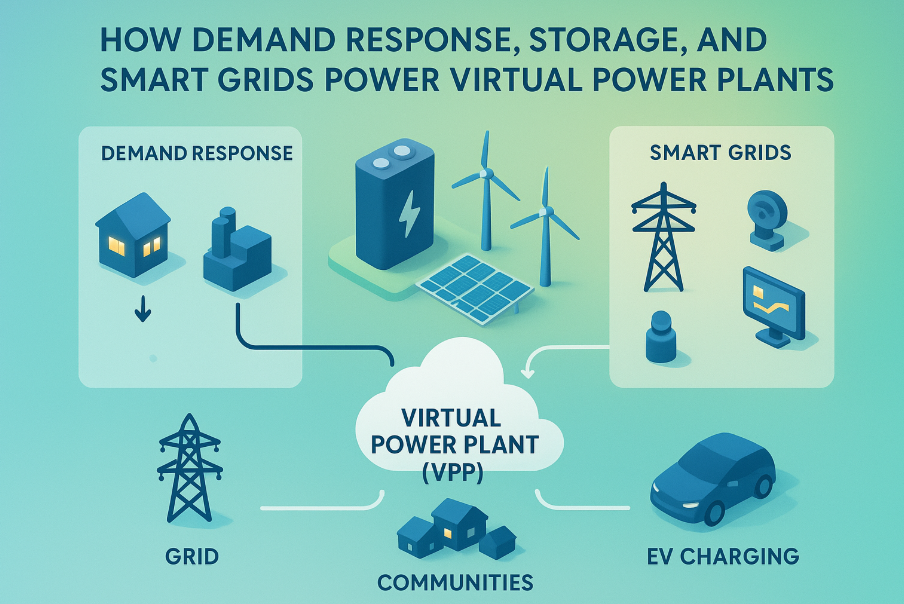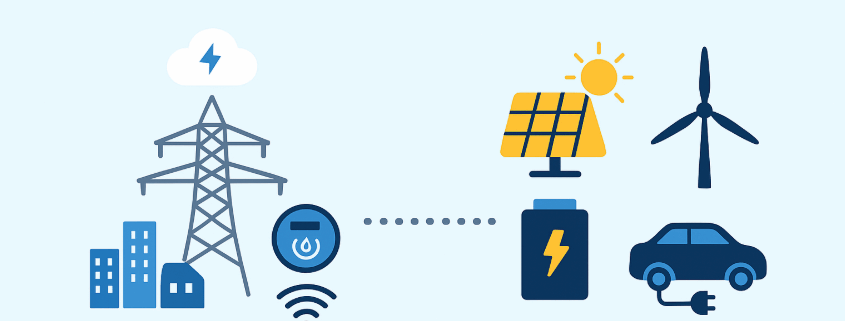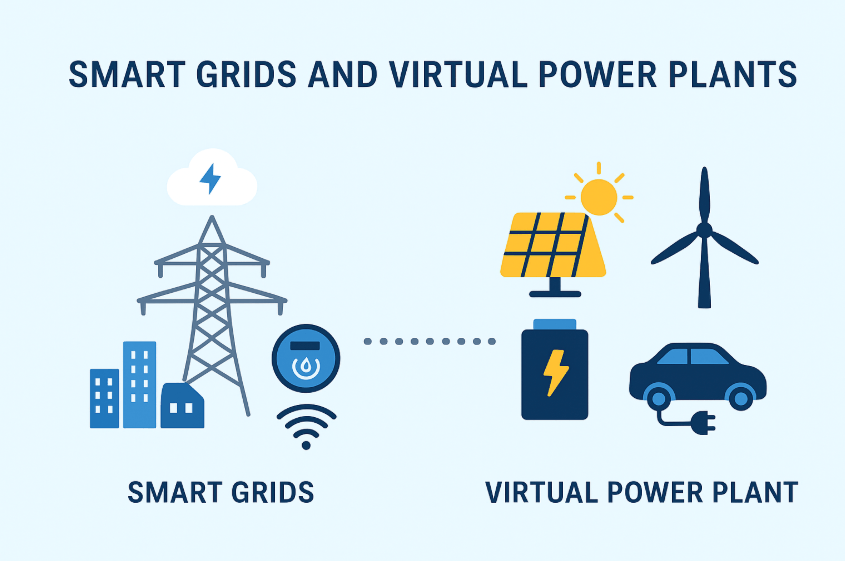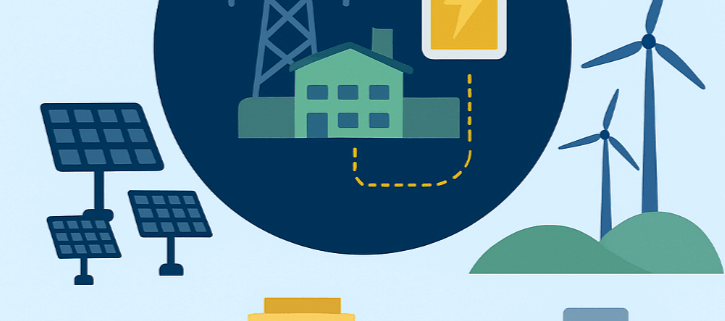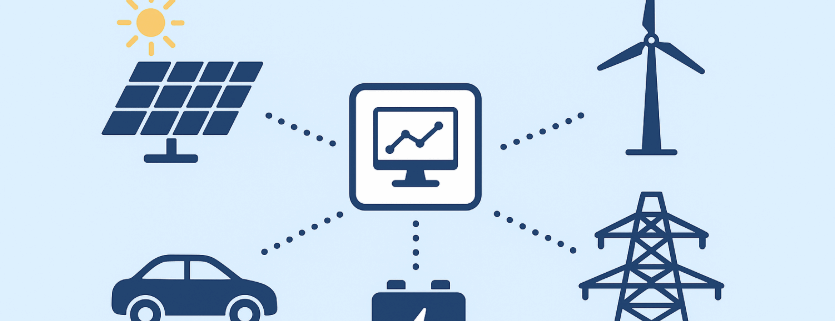Introduction to Virtual Power Plants: Energy systems around the world are undergoing a massive transformation. The growing demand for renewable energy, the rise of electric vehicles, and the need for smarter grids have created challenges for traditional infrastructure. At the heart of this transformation lies a powerful innovation—Virtual Power Plants (VPPs).
A Virtual Power Plant is a digital platform that integrates distributed energy resources (DERs), such as solar panels, wind turbines, battery storage, and electric vehicles, into a unified system. Unlike conventional plants, which rely on centralized infrastructure, VPPs orchestrate energy flows through advanced software, ensuring that renewable energy becomes both reliable and flexible.
This article explores in detail the role of Virtual Power Plants, their reliance on battery energy storage, their benefits, challenges, and future potential in shaping global energy systems.
What Exactly Are Virtual Power Plants?
Virtual Power Plants (VPPs) are not physical facilities. They are digital networks that connect and control multiple distributed energy assets. These assets can be as small as a household rooftop solar panel or as large as a community-scale wind farm.
Through cloud-based platforms, each connected asset communicates real-time data about its energy production and consumption. The VPP software then aggregates this information, predicting demand, managing supply, and dispatching electricity where it is needed most.
Unlike traditional plants that burn coal or gas, VPPs depend on renewable energy and energy storage. By digitally coordinating thousands of smaller systems, a Virtual Power Plant behaves like a large, flexible power station.
How Virtual Power Plants Operate in Practice
The operation of a VPP involves advanced analytics, artificial intelligence, and real-time communication. The process can be broken down into three key stages:
- Data Collection: Smart meters, IoT devices, and sensors track production and demand across distributed resources.
- Optimization: The VPP platform forecasts future demand and renewable generation. Algorithms decide when to charge batteries, when to discharge them, and how to balance the grid.
- Energy Dispatch: The system distributes power back to the grid, ensures local consumption is met, or stores excess energy for later use.
This digital coordination allows VPPs to react in seconds—something conventional power plants cannot achieve without significant delays.
The Role of Battery Energy Storage in Virtual Power Plants
While Virtual Power Plants integrate many resources, battery energy storage systems (BESS) are at their core. Renewable energy is intermittent—solar panels produce during daylight, and wind turbines depend on weather. Batteries solve this variability by storing excess electricity and releasing it when demand spikes.
Functions of Batteries in VPPs:
Without batteries, Virtual Power Plants would struggle to maintain consistency. With them, VPPs become reliable, scalable, and profitable.
Benefits of Virtual Power Plants
The adoption of VPPs creates a wide range of benefits across the energy ecosystem.
For Consumers
- Lower electricity bills through optimized energy use.
- Ability to sell excess electricity to the grid.
- Access to cleaner, more reliable power.
For Utilities
For Governments
- Faster achievement of carbon reduction targets.
- Improved energy security and independence.
- Decentralized grids that are more resilient against failures.
For the Environment
The combined impact positions Virtual Power Plants as a cornerstone of future energy systems.
Virtual Power Plants vs Traditional Power Plants
The contrast between traditional power plants and Virtual Power Plants highlights the shift in global energy strategy.
- Traditional Plants: Centralized, fossil-fuel-based, and slow to adapt. They require heavy investments, produce high emissions, and are vulnerable to single points of failure.
- Virtual Power Plants: Decentralized, renewable-focused, and highly flexible. They scale easily, integrate distributed resources, and increase resilience.
Instead of replacing one large plant with another, VPPs aggregate thousands of smaller assets into a reliable, coordinated system. This decentralized model represents the future of global electricity markets.
Real-World Examples of Virtual Power Plants
Several countries are already leading in VPP deployment:
- Australia: The South Australia VPP connects thousands of home batteries and solar panels, creating one of the largest distributed power systems in the world. It reduces peak costs and strengthens reliability.
- Germany: Operators aggregate wind farms, solar farms, and BESS to provide essential services such as frequency regulation and grid balancing.
- United States: Utilities deploy battery-backed VPPs to avoid building new natural gas plants. These systems supply energy during peak demand while lowering carbon emissions.
Each case study demonstrates that VPPs are not experimental—they are already reshaping how energy is produced and consumed.
Challenges Facing Virtual Power Plants
Despite the advantages, Virtual Power Plants face significant challenges.
- Cost of Batteries: Large-scale storage remains expensive, though costs are falling steadily.
- Technology Integration: Connecting thousands of assets requires advanced and secure communication infrastructure.
- Policy Barriers: Regulatory systems in many countries still favor centralized generation, limiting VPP participation.
- Resource Availability: Manufacturing batteries at scale requires stable supplies of lithium, cobalt, and nickel.
Addressing these challenges will be key to unlocking the full potential of Virtual Power Plants.
The Impact of Virtual Power Plants on Energy Markets
VPPs are reshaping electricity markets by introducing new business models and trading opportunities. They enable households and businesses to become “prosumers,” meaning they both produce and consume electricity.
Through demand response programs, VPP participants are rewarded for adjusting their consumption patterns. For example, reducing air conditioning use during peak hours or charging electric vehicles at night can generate income for consumers while stabilizing the grid.
This market participation transforms energy from a one-way system into a dynamic, two-way interaction.
The Role of Electric Vehicles in VPPs
Electric vehicles (EVs) are poised to play a massive role in Virtual Power Plants. Each EV battery can act as a mobile storage unit. When thousands of EVs are aggregated into a VPP, they form a powerful distributed energy reserve.
This model, known as Vehicle-to-Grid (V2G), allows EVs to discharge electricity back into the grid when demand rises and recharge when supply is abundant. The combination of EVs and VPPs could provide gigawatts of flexible energy in the future.
The Future of Virtual Power Plants
The future of Virtual Power Plants looks promising as technologies evolve.
- AI and Machine Learning: Smarter forecasting and decision-making will optimize energy flows.
- Blockchain: Transparent and secure peer-to-peer energy trading.
- Next-Generation Batteries: Solid-state and flow batteries will extend lifespan and reduce costs.
- Smart Appliances: Homes and businesses will become active participants, further expanding the VPP ecosystem.
By 2030, experts predict that Virtual Power Plants will become a central feature of electricity markets worldwide, replacing many traditional fossil-fuel plants and accelerating the transition to clean energy.
Conclusion
Virtual Power Plants represent a paradigm shift in how the world generates, stores, and consumes electricity. By combining distributed resources, integrating battery energy storage, and leveraging advanced software, VPPs create a system that is cleaner, more flexible, and far more resilient than traditional models.
With falling battery costs, growing renewable adoption, and the rise of electric vehicles, Virtual Power Plants are positioned to become the backbone of future energy systems. The transformation is not only technical—it is economic, social, and environmental.
As nations pursue decarbonization goals and energy independence, Virtual Power Plants will emerge as a key solution for powering the world sustainably.
